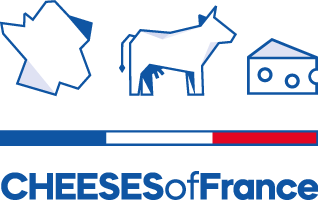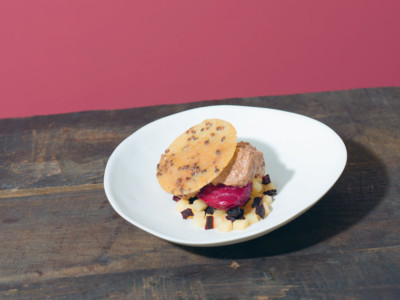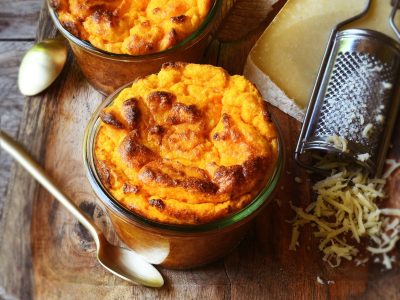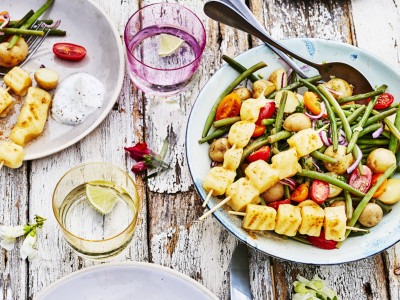Antoine Roussel was a peasant farmer who lived some 40 km outside Clermont-Ferrand. Around 1855, he stumbled on the idea of seeding the milk from his dairy herd with the mould found on rye bread, then piercing the curd with a knitting needle to introduce air. The result was Bleu d’Auvergne, which achieved PDO status in 1996. Bleu d’Auvergne is the most famous of the blueveined cheeses produced in the Massif Central; the production area extends from Puy-de-Dôme to Cantal, and includes Aveyron, Corrèze, Haute-Loire, Lot and Lozère. It takes 20 to 25 litres of milk to produce a Roquefort which weighs 2 to 3 kg after being aged for a minimum of 4 weeks. Penicillium Roqueforti is added to the milk in the initial stages, but forms its familiar blue veins during maturation, when the salted cheese is pierced by hand using needles. This makes it creamy and full flavoured – the hallmarks of Bleu d’Auvergne.

© Nathalie Carnet
Sweet and blue
recipe from chef Mathew Hegarty- 4
- 1 h
- 3 h
Ingredients
- For the shortbread base
- 100 g breadcrumbs
- 15 g sugar
- 1 g Tasmanian pepper
- 40 g white chocolate
- 60 g butter
- For the cheesecake
- 20 g milk
- 1 g agar-agar
- 30 g sugar
- 120 g Bleu d’Auvergne
- 1 tbsp wattle seeds
- 50 g 30% cream
- For the eucalyptus jelly
- 100 ml water
- 15 g sugar
- 30 eucalyptus leaves
- 1 g agar-agar
- For the Bleu d’Auvergne ice-cream:
- 6 egg yolks
- 100 g sugar
- 300 ml milk
- 300 g Bleu d’Auvergne
- For the Bleu d’Auvergne chips
- 150 ml water
- 100 g sugar
- 300 g Bleu d’Auvergne
- To finish
- Wood-sorrel leaves and caviar lime
Method
Make the shortbread
- Combine the breadcrumbs, sugar and pepper in a bowl.
- Melt the chocolate and butter together in a saucepan and add to the dry ingredients to make a smooth dough.
- Using a 3cm cookie cutter, cut out circles to form the base of the cheesecakes.
Make the cheesecake
- Heat the milk, the agar-agar and the sugar in a saucepan.
- Bring to the boil, and add the Bleu d’Auvergne and wattle seeds.
- Tip the mixture into a large bowl.
- Whisk the 50 g of cream to soft peaks and fold into the milk and cheese mixture.
- Turn into 8 silicon half-sphere moulds, each 3 cm in diameter. Chill.
Make the eucalyptus jelly
- Heat the water, sugar and eucalyptus leaves in a saucepan.
- Remove from the heat, cover with cling film and leave to infuse for 20 minutes.
- Strain, reserving the liquid only.
- Boil, stirring in the agar-agar and leave in the fridge to set for 30 minutes.
- Blend with a stick blender to a smooth, gel-like texture.
Make the Bleu d’Auvergne ice-cream
- Mix the egg yolks and sugar together in a bowl.
- Bring the milk to the boil.
- Pour the boiling milk into the eggs and sugar, whisking all the time.
- Pour the mixture back into a saucepan and simmer over a gentle heat, stirring constantly, without going over 83°C.
- Add the diced Bleu d’Auvergne.
- Blend, transfer to a Pacojet or ice-cream maker and freeze for a minimum of 4 hours.
Make the Bleu d’Auvergne chips
- Preheat the oven to 90°C.
- Heat the water, sugar and Bleu d’Auvergne in a saucepan.
- When the cheese has melted, blend in a food processor and spread over a sheet of baking paper.
- Leave to set for 2-3 hours, then break up to make chips.
To assemble
- Remove the half-spheres of cheesecake filling from the fridge.
- Arrange two discs of shortbread on each plate, and top each with the cheesecake filling.
- Using a spoon, carefully position a quenelle of Bleu d’Auvergne ice-cream between the two cheesecakes.
- Sprinkle the cheesecakes with Bleu d’Auvergne chips; decorate with piped eucalyptus jelly and garnish with wood-sorrel leavesand caviar lime.
Autoriser
Mathew Hegarty
Mathew Hegarty was born in Australia, in a small city about an hour’s drive from Sydney. Since 2015, he has been chef at Le P’tit Polyte, Chalet Mounier’s gourmet restaurant in the ski resort of Les Deux Alpes (Isère). Just one year after he arrived, Mathew’s cooking skills earned him a Michelin star. His style is influenced by his Australian background, and inspired by Asian cuisine. He came to the public eye in 2018 as a contestant in season 9 of Top Chef TV programme (M6). When he first arrived in the country in 2010, Mathew trained under Yannick Delpech in Toulouse; he then did his own mini Tour de France, taking in Corsica, Brittany and Haute-Savoie before settling here for the duration. Mathew was brought up in the foothills of the Blue Mountains. For Sweet Cheese, he’s cooking Bleu d’Auvergne, at 1,600m above sea level. A real case of back to his roots!
 繁體中文
繁體中文  简体中文
简体中文  한국어
한국어  Français
Français 







